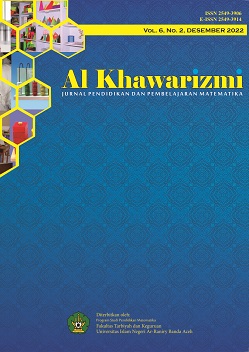Students’ Mathematical Problem Solving Ability Based on The Steps of Ideal Problem Solving Viewed From Adversity Quotient (AQ)
DOI:
https://doi.org/10.22373/jppm.v7i1.18211Keywords:
Mathematical Problem Solving Ability, IDEAL Problem Solving, Adversity Quotient (AQ), Climber, Camper, QuitterAbstract
The ability of problem solving is one of essential mathematical abilities in learning mathematics. The facts in the field indicated that the problem solving ability of senior high school students were still low. Adversity Quotient (AQ) was presumed to play a role in the ability of students in solving problems. This research intended to describe the ability of students’ mathematical problem solving in accordance with the steps of IDEAL problem solving viewed from their AQ. The participants were consisted of three students of grade XI in one senior high school in Banda Aceh. The research finding indicates that the problem solving abilities of the students using steps of IDEAL problem solving regarding their AQ are differ. The climber solved problems by using all the steps of IDEAL problem solving, the camper only did four steps, and the quitter did not do any of the steps in solving the problem.References
Arslan, C., & Yagzan, Y. (2015). Common and flexible use of mathematical non routine problem solving strategies. American Journal of Educational Research, 3(12), 1519-1523. https://doi.org /10.12691/education-3-12-6
Bennu, S. (2012). Adversity quotient: Kajian kemungkinan pengintegrasiannya dalam pembelajaran matematika. AKSIOMA, 1(1), 55-62. Retrieved from http://jurnal.untad.ac.id/jurnal/index.php/AKSIOMA/index
Brookhart, S. M. (2010). How to assess higher-order thinking skills in your classroom. USA: ASCD.
Cockcroft, W. H. (1982). Mathematics counts. London: HM Stationery Office.
Deesom, N. (2011). The result of a positive thinking program to the adversity quotient of matthayom suksa VI students. International Proceedings of Economics Development & Research, 5(3), 9-10. http://ipedr.com/
Devakumar, Ms. M. (2012). A study of adversity quotient of secondary school students in relation to their academic self concept and achievement motivation. Doctoral dissertation, unpublished. Department of Education University of Mumbai: Mumbai. https://www.peaklearning.com/
Dina, N. A., Amin, S. M., & Masriyah. (2018). Flexibility in mathematics problem solving based on adversity quotient. Journal of Physics: Conference Series, 947(1), 12-25. https://doi.org /10.1088/1742-6596/947/1/012025
Fauziyah, L., Nur, I., & Usodo, B. (2013). Proses berpikir kreatif siswa kelas X dalam memecahkan masalah geometri berdasarkan tahapan wallas ditinjau dari adversity quotient (AQ) siswa. Jurnal Pendidikan Matematika Solusi, 1(1), 1-16. https://eprints.uns.ac.id/
Hsiao, H. S., Chang, C. S., Chen, C. J., Wu, C. H., & Lin, C. Y. (2015). The influence of Chinese character handwriting diagnosis and remedial instruction system on learners of Chinese as a foreign language. Computer Assisted Language Learning, 28(4), 306-324. http://dx.doi.org/10.1080/09588221.2013.818562
Kairienė, B. (2017). The duties of a pupil: The implementation problem. Pedagogika, 126(2), 130-142. http://dx.doi.org/10.15823/p.2017.24
Kloosterman, P., & Stage, F. K. (1992). Measuring beliefs about mathematical problem solving. School Science and Mathematics, 92(3), 109-115. https://doi.org/10.1111/j.1949-8594.1992.tb12154.x
Lester, F. K., & Kehle, P. E. (2003). From Problem Solving to Modeling: The Evolution of Thinking about Research on Complex Mathematical Activity. In R. Lesh & H. Doerr, (Eds.), Beyond Constructivism: Models and Modeling Perspectives on Mathematics Problem Solving, Learning, and Teaching (pp. 501-518). Mahwah, NJ: Erlbaum.
Mayer, R. E. (1982). The psychology of mathematical problem solving. In F. K. Lester, & J. Garofalo (Eds.), Mathematical problem-solving: Issues in research (pp.1-13). Philadelphia: The Franklin Institute Press.
Mayer, R. E. (1987). Learnable aspects of problem solving: Some examples. In D. E. Berger, K. Pezdek, & W. P. Banks (Eds.), Applications of cognitive psychology: Problem solving, education and computing (pp.109-122). Hillsdale, NJ: Lawrence Erlbaum Associates.
Miles, M. B., Huberman, A. M. (1992). Qualitative data analysis: Buku sumber tentang metode-metode baru (Tjetjep Rohendi Rohidi, Trans.). Jakarta: Universitas Indonesia (UI-Press).
National Council of Teachers of Mathematics. (1989). Curriculum and evaluation standards for school mathematics. Reston, VA: Author.
National Council of Teachers of Mathematics. (2000). Principles and standards for school mathematics. Reston, VA: Author.
OECD. (2014). PISA 2012 results: what students know and can do – student performance in mathematics, reading, and science (Volume 1, Revised Edition, February 2014). PISA: OECD Publishing.
OECD. (2016). PISA 2015 Results in Focus. PISA. OECD Publishing.
Oliveros, J. C. (2014). Adversity quotient and problem-solving skills in advanced algebra. JPAIR Multidisciplinary Research, 17(1), 65-75. https://doi.org/10.7719/jpair.v17i1.282
Pape, S. J., & Wang, C. (2003). Middle school children’s strategic behavior: Classification and relation to academic achievement and mathematical problem solving. Instructional Science, 31(6), 419-449. https://doi.org/ 10.1023/A:1025710707285
Pečiuliauskienė, P., & Damauskienė L. (2013). Impact of the assessment of tenth-formers’ achievements in mathematics on learning motivation. PEDAGOGIKA, 109(1), 110-117. Retrieved from http://www.pedagogika.leu.lt/index.php/Pedagogika/index
Sahyar., & Fitri, R. Y. (2017). The effect of problem-based learning model (PBL) and adversity quotient (AQ) on problem-solving ability. American Journal of Educational Research, 5(2), 179-183. https://doi.org/10.12691/education-5-2-11
Santosa, N., Waluya, St. B., Sukestiyarno. (2013). Kemampuan pemecahan masalah pada pembelajaran matematika dengan strategi master dan penerapan scaffolding. Unnes Journal of Mathematics Education Research, 2(2), 69-75. Retrieved from https://journal.unnes.ac.id/sju/index.php/ujmer/index
Sari, C. K., Sutopo, S., & Aryuna, D. R. (2016). The profile of students’ thinking in solving mathematics problems based on adversity quotient. Journal of Research and Advances in Mathematics Education (JRAMathEdu), 1(1), 36-48. https://doi.org/10.23917/jramathedu.v1i1.1784
Schoenfeld, A. H. (2016). Learning to think mathematically: problem solving, metacognition, and sense making in mathematics (reprint). Journal of Education, 196(2), 1-38. https://doi.org/10.1177/002205741619600202
Stoltz, P. G. (1997). Adversity quotient: Turning obstacles into opportunities. Canada: John Wiley & Sons, Inc.
Stoltz, P. G. (2000). Adversity quotient: Mengubah hambatan menjadi peluang. (T. Hermaya, Trans.) Jakarta: PT Grasindo.
Suryadi, B., & Santoso, T. I. (2017). Self-efficacy, adversity quotient, and students’ achievement in mathematics. International Education Studies. 10(10), 12-19. https://doi.org/10.5539/ies.v10n10p12
Yani, M., Ikhsan, M., & Marwan. (2016). Proses berpikir siswa sekolah menengah pertama dalam memecahkan masalah matematika berdasarkan langkah-langkah polya ditinjau dari adversity quotient. Jurnal Pendidikan Matematika, 10(1), 42-57. http://dx.doi.org/10.22342/jpm.10.1.3278.42-57

